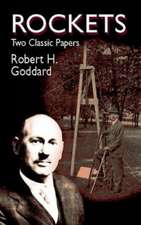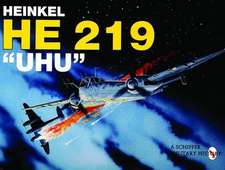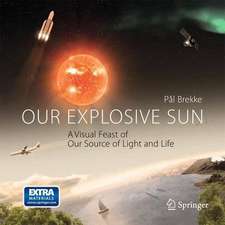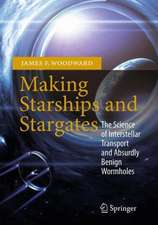Emigrating Beyond Earth: Human Adaptation and Space Colonization: Springer Praxis Books
Autor Cameron M Smith, Evan T. Daviesen Limba Engleză Paperback – 12 iun 2012
Din seria Springer Praxis Books
-
 Preț: 294.46 lei
Preț: 294.46 lei -
 Preț: 223.45 lei
Preț: 223.45 lei -
 Preț: 193.12 lei
Preț: 193.12 lei -
 Preț: 167.85 lei
Preț: 167.85 lei -
 Preț: 288.98 lei
Preț: 288.98 lei -
 Preț: 323.74 lei
Preț: 323.74 lei -
 Preț: 401.38 lei
Preț: 401.38 lei -
 Preț: 264.12 lei
Preț: 264.12 lei - 8%
 Preț: 513.00 lei
Preț: 513.00 lei -
 Preț: 190.01 lei
Preț: 190.01 lei -
 Preț: 218.16 lei
Preț: 218.16 lei -
 Preț: 312.06 lei
Preț: 312.06 lei - 17%
 Preț: 414.05 lei
Preț: 414.05 lei -
 Preț: 216.41 lei
Preț: 216.41 lei -
 Preț: 262.27 lei
Preț: 262.27 lei -
 Preț: 264.35 lei
Preț: 264.35 lei -
 Preț: 167.63 lei
Preț: 167.63 lei -
 Preț: 284.81 lei
Preț: 284.81 lei -
 Preț: 259.08 lei
Preț: 259.08 lei -
 Preț: 305.47 lei
Preț: 305.47 lei -
 Preț: 244.14 lei
Preț: 244.14 lei -
 Preț: 227.85 lei
Preț: 227.85 lei -
 Preț: 285.25 lei
Preț: 285.25 lei -
 Preț: 295.56 lei
Preț: 295.56 lei -
 Preț: 357.17 lei
Preț: 357.17 lei -
 Preț: 275.79 lei
Preț: 275.79 lei -
 Preț: 257.08 lei
Preț: 257.08 lei -
 Preț: 349.71 lei
Preț: 349.71 lei -
 Preț: 272.45 lei
Preț: 272.45 lei -
 Preț: 270.27 lei
Preț: 270.27 lei - 8%
 Preț: 456.51 lei
Preț: 456.51 lei -
 Preț: 352.34 lei
Preț: 352.34 lei - 8%
 Preț: 394.80 lei
Preț: 394.80 lei -
 Preț: 320.65 lei
Preț: 320.65 lei -
 Preț: 325.29 lei
Preț: 325.29 lei -
 Preț: 253.11 lei
Preț: 253.11 lei -
 Preț: 192.86 lei
Preț: 192.86 lei -
 Preț: 313.40 lei
Preț: 313.40 lei -
 Preț: 150.51 lei
Preț: 150.51 lei -
 Preț: 233.34 lei
Preț: 233.34 lei -
 Preț: 286.78 lei
Preț: 286.78 lei -
 Preț: 212.01 lei
Preț: 212.01 lei -
 Preț: 366.83 lei
Preț: 366.83 lei -
 Preț: 299.99 lei
Preț: 299.99 lei -
 Preț: 232.27 lei
Preț: 232.27 lei -
 Preț: 284.58 lei
Preț: 284.58 lei -
 Preț: 212.45 lei
Preț: 212.45 lei -
 Preț: 159.81 lei
Preț: 159.81 lei -
 Preț: 349.48 lei
Preț: 349.48 lei - 20%
 Preț: 2061.64 lei
Preț: 2061.64 lei
Preț: 257.28 lei
Nou
Puncte Express: 386
Preț estimativ în valută:
49.24€ • 51.21$ • 40.65£
49.24€ • 51.21$ • 40.65£
Carte disponibilă
Livrare economică 22 martie-05 aprilie
Preluare comenzi: 021 569.72.76
Specificații
ISBN-13: 9781461411642
ISBN-10: 1461411645
Pagini: 316
Ilustrații: XXIII, 290 p. 45 illus.
Dimensiuni: 168 x 240 x 18 mm
Greutate: 0.5 kg
Ediția:2012
Editura: Springer
Colecția Springer
Seriile Springer Praxis Books, Popular Science
Locul publicării:New York, NY, United States
ISBN-10: 1461411645
Pagini: 316
Ilustrații: XXIII, 290 p. 45 illus.
Dimensiuni: 168 x 240 x 18 mm
Greutate: 0.5 kg
Ediția:2012
Editura: Springer
Colecția Springer
Seriile Springer Praxis Books, Popular Science
Locul publicării:New York, NY, United States
Public țintă
Popular/generalCuprins
List of Figures.- List of Tables.- Acknowledgements and Dedications.- About the Authors.- Preface.- Part I: The Context and Uniqueness of Human Evolution and Adaptation.- Chapter 1: The Extraterrestrial Adaptation: Humanity, Evolution and Migration Into Space.- Chapter 2: Stardust: The Origins of Life, Evolution and Adaptation.- Chapter 3: The Adaptive Equipment of the Genus Homo: Symbolism and Niche Construction.- Part II: Arguments For and Against Human Space Colonization.- Chapter 4: A Choice of Catastrophes - Common Arguments for Space Colonization.- Chapter 5: False Choices - Common Objections to Human Space Colonization.- Part III: Human Adaptation to Space - Lessons from the Past and Shaping the Future.- Chapter 6: Starpaths - Adaptation to Oceania.- Chapter 7: Building an Adaptive Framework for Human Future in Space.- Bibliography.- Index.
Recenzii
From the book reviews:
“This book would be a good introduction to the idea of space colonization for those who otherwise might consider it as an utopian idea while reading about the technologies necessary for transporting hundreds of people to distant locations in the Solar System and possibly terraforming a planet. ‘Emigrating Beyond Earth’ shows it all more in a way that’s easily understandable and logical without too much previous knowledge.” (Kadri Tinn, Astromadness.com, September, 2014)
“A basic premise of this work is that ‘human migration into space will be the continuation of the natural process of evolution.’ … the authors examine the pros and cons of colonization and conclude that it both can and should be attempted. To support their case, they note some potential catastrophes that could lead to the extinction of humans, and believe that space colonization may be necessary for the survival of the human species. … Summing Up: Recommended. Lower- and upper-division undergraduates and general readers.” (T. Barker, Choice, Vol. 50 (6), February, 2013)
“This book would be a good introduction to the idea of space colonization for those who otherwise might consider it as an utopian idea while reading about the technologies necessary for transporting hundreds of people to distant locations in the Solar System and possibly terraforming a planet. ‘Emigrating Beyond Earth’ shows it all more in a way that’s easily understandable and logical without too much previous knowledge.” (Kadri Tinn, Astromadness.com, September, 2014)
“A basic premise of this work is that ‘human migration into space will be the continuation of the natural process of evolution.’ … the authors examine the pros and cons of colonization and conclude that it both can and should be attempted. To support their case, they note some potential catastrophes that could lead to the extinction of humans, and believe that space colonization may be necessary for the survival of the human species. … Summing Up: Recommended. Lower- and upper-division undergraduates and general readers.” (T. Barker, Choice, Vol. 50 (6), February, 2013)
Notă biografică
Dr. Cameron M. Smith, Ph.D., teaches human evolution and prehistory at the Department of Anthropology at Portland State University in Oregon. His professional training began as a student of Harvard University's early human archaeology field school at the Leakey research station in northern Kenya. After a year at the University of London's Institite of Archaeology, Dr. Smith earned a Joint Honors BA in Anthropology and Archaeology at Durham University before completing graduate degrees in the US and Canada. His courses emphasize adaptation and evolution as structuring factors of human prehistory. Dr. Smith has been widely published in both scientific journals and popular science magazines, including the American Journal of Physical Anthropology, Structure and Dynamics, the Journal of Field Archaeology, Scientific American MIND, Scientific American, Evolution: Education and Outreach, Archaeology, Hang Gliding and Paragliding and Spaceflight. He has written about evolution book and magazines including The Top Ten Myths About Evolution (Prometheus, 2006) endorsed by the National Center for Science Education and the American Library Association, and The Fact of Evolution (Prometheus, 2011) endorsed by Science Daily and recently picked for the Scientific American Book Club. Away from his office, Dr.Smith is an active Scuba diver and paraglider pilot. He is a fellow of both the Royal Geographical Society and the Explorers Club of New York.
Evan T. Davies, Ph.D., began his academic training in archaeology at Cornell University and has conducted fieldwork throughout the United States, Europe, sub-Saharan Africa and the South Pacific. He completed his graduate studies in cultural anthropology at Rice University, where he focused on land use among traditional hunter-gatherer societies in Central Africa. He serves as a defense attache, African area expert and imagery scientist in the United StatesNavy. In 2007 while deployed on a combat tour with the multi-national forces in Iraq, Dr. Davies became involved with efforts to preserve Iraqi antiquities and archaeological sites. His experiences in Iraq led him to pursue medical studies and in the coming years he intends to work in wilderness and expedition medicine as well as continue anthropological research into indigenous pharmaceuticals and healing practices. Dr. Davies is a fellow of both the Royal Geographical Society and the Explorers Club of New York and his popular science writing has appeared in Wiley publications as well as Spaceflight and Archaeology magazines. He has a held a lifelong interest in space exploration.
Evan T. Davies, Ph.D., began his academic training in archaeology at Cornell University and has conducted fieldwork throughout the United States, Europe, sub-Saharan Africa and the South Pacific. He completed his graduate studies in cultural anthropology at Rice University, where he focused on land use among traditional hunter-gatherer societies in Central Africa. He serves as a defense attache, African area expert and imagery scientist in the United StatesNavy. In 2007 while deployed on a combat tour with the multi-national forces in Iraq, Dr. Davies became involved with efforts to preserve Iraqi antiquities and archaeological sites. His experiences in Iraq led him to pursue medical studies and in the coming years he intends to work in wilderness and expedition medicine as well as continue anthropological research into indigenous pharmaceuticals and healing practices. Dr. Davies is a fellow of both the Royal Geographical Society and the Explorers Club of New York and his popular science writing has appeared in Wiley publications as well as Spaceflight and Archaeology magazines. He has a held a lifelong interest in space exploration.
Textul de pe ultima copertă
For four million years humankind has been actively expanding geographically and in doing so has adapted to a wide variety of hostile environments. Now we are looking towards the ultimate adaptation - the colonization of space. Emigrating Beyond Earth illustrates that this is not a technocratic endeavor, but a natural continuation of human evolution; a journey not just for the engineer and rocket scientist, but for everyman. Based on the most current understanding of our universe, human adaptation and evolution, the authors explain why space colonization must be planned as an adaptation to, rather than the conquest of, space.
Emigrating Beyond Earth argues that space colonization is an insurance policy for our species, and that it isn't about rockets and robots, it's about humans doing what we've been doing for four million years: finding new places and new ways to live.
Applying a unique anthropological approach, the authors outline a framework for continued human space exploration and offer a glimpse of a possible human future involving interstellar travel and settlement of worlds beyond our own.
Emigrating Beyond Earth argues that space colonization is an insurance policy for our species, and that it isn't about rockets and robots, it's about humans doing what we've been doing for four million years: finding new places and new ways to live.
Applying a unique anthropological approach, the authors outline a framework for continued human space exploration and offer a glimpse of a possible human future involving interstellar travel and settlement of worlds beyond our own.
Caracteristici
Focuses on the anthropological reasons for space colonization, essentially the human need to spread out into new environments to protect against extinction Shows how space colonization is a natural continuation of humanity's 4-million-year history of migration and adaptation Uses the stories of the colonization of the Arctic and the Pacific islands as models of migration behavior Includes supplementary material: sn.pub/extras Includes supplementary material: sn.pub/extras
















